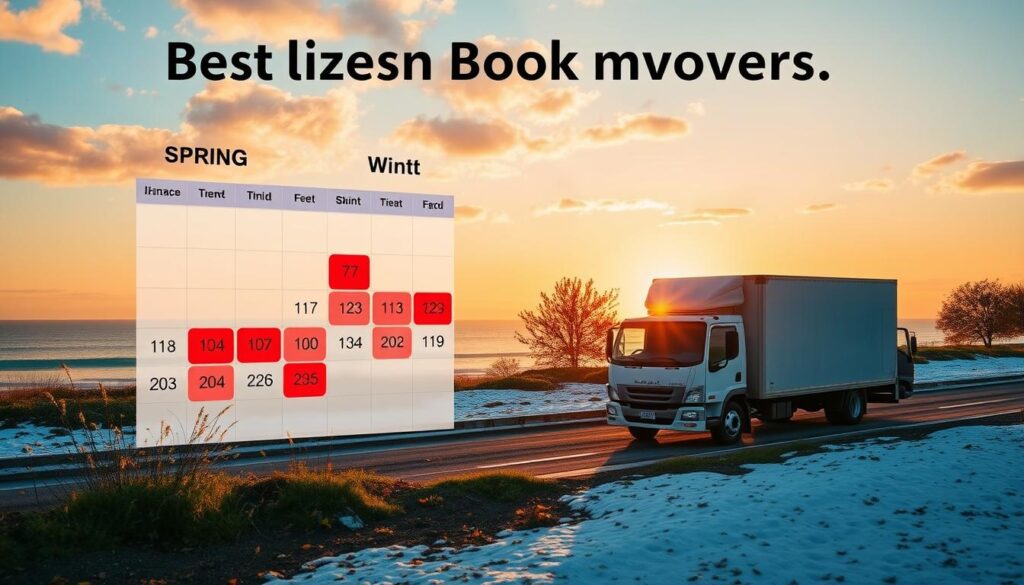How Much Does It Cost to Hire Long Distance Movers?
Get Your Free Moving Estimate
When considering a move across states or even across the country, one of the most pressing questions is: how much does it cost to hire long distance movers? At HeavenlyMove, we understand that pricing can vary widely based on multiple factors. With over two decades of experience and a 4.9-star rating on Google, our goal is to provide clarity and transparency around long distance moving company prices. We offer reliable insights to help you find affordable long distance movers that meet your needs, ensuring you feel informed and supported throughout your moving journey.
Key Takeaways
- Understanding long distance moving costs is crucial for effective budgeting.
- Multiple factors influence how much you will pay for your move.
- There are diverse pricing models among long distance moving companies.
- Inventory management can help in estimating your moving costs accurately.
- Finding an affordable long distance mover can alleviate financial stress.
Understanding Long Distance Moving Costs
Moving long distances can seem daunting, especially when it comes to understanding how much it will cost. Several factors influence the overall expenses associated with a move. Knowing these elements helps you prepare for your cross-country moving cost estimate, compare various services, and budget appropriately.
Factors Influencing the Cost
Multiple factors come into play when calculating moving costs. Here are some key influences:
- Distance of the move: Generally, longer distances increase the cost.
- Weight of belongings: Heavier loads typically raise transport costs.
- Season and timing: Summer months usually experience higher demand, leading to increased prices.
- Specific services required: Options like packing, storage, or unpacking can add to the cost.
- Type of moving company: Professional interstate moving quotes can vary greatly depending on the trend and reputation of the movers.
Average Price Ranges
Understanding the average price for out of state move can help you establish a realistic budget. Here’s a general breakdown of typical costs:
| Distance | Estimate (Low End) | Estimate (High End) |
|---|---|---|
| Under 250 miles | $800 | $2,500 |
| 250 – 500 miles | $1,200 | $3,000 |
| 500 – 1,000 miles | $1,800 | $4,500 |
| Over 1,000 miles | $2,500 | $7,500 |
Types of Long Distance Moving Services
Understanding the range of long-distance moving services can greatly influence your moving experience. We recognize that different customers have varying needs based on their preferences, budgets, and timelines. Below, we explore two primary types of moving services offered by the best long distance moving companies.
Full-Service Moves
Full-service moves provide comprehensive support for your relocation, allowing you to focus on settling into your new home. These services typically include:
- Packing all of your belongings
- Loading the moving truck
- Transporting items to your new location
- Unpacking and arranging your belongings
Opting for full-service moving with affordable long distance movers can alleviate the stress often associated with local and long-distance moving. Your dedicated moving team will handle all aspects, ensuring your move is seamless from start to finish.
Self-Service Options
For those who wish to take a more hands-on approach, self-service moving solutions are available. These options allow you to manage your relocation independently while still accessing professional support as needed. Key features of self-service solutions include:
- Container rentals for packing and loading your valuables
- Transportation for your packed containers
- Flexible scheduling to suit your timeline
This choice often appeals to budget-conscious individuals looking to save on costs while still receiving exceptional service from reliable moving companies.
Estimating Moving Volume and Weight
Accurate estimation of your moving volume and weight plays a vital role in determining the overall cost of your move. Using a long distance moving cost calculator can help simplify this process by providing a clearer picture of the expenses involved. Understanding how to calculate your belongings can significantly aid in obtaining a precise professional interstate moving quote.
How to Calculate Your Belongings
Begin by assessing all items you plan to move. Start with a thorough examination of each room in your home or office. Utilize the following strategies for effective calculations:
- Measure larger items to obtain necessary dimensions.
- Estimate the weight of boxes based on their contents.
- Use a moving calculator tool available online for added accuracy.
Importance of Taking Inventory
Implementing proper inventory management for moving not only streamlines the process but also prevents unexpected expenses. A detailed inventory ensures that you:
- Have a clear overview of what needs to be moved.
- Know how to optimize your space in the moving truck.
- Track your belongings during the move.
By adopting these budget-friendly moving strategies and establishing a comprehensive inventory, you position yourself for a successful relocation experience. This structured approach can lead to more effective planning and a smoother transition to your new home or office.

| Item Type | Estimated Weight (lbs) | Volume (cubic ft) |
|---|---|---|
| Sofa | 150 | 30 |
| Dining Table | 100 | 15 |
| Bed Frame | 75 | 12 |
| Box (medium) | 30 | 3 |
| Box (large) | 60 | 6 |
Additional Fees and Charges to Consider
When planning your move, it’s essential to account for additional fees and charges that often arise unexpectedly. These hidden costs to watch out for can significantly impact your overall budget. Understanding these expenses can help us manage long distance moving company prices effectively and ensure transparency in the moving process.
Fuel Surcharges
Fuel surcharges represent an extra cost linked to the fluctuating price of gas. Many long distance moving companies include this in their estimates. This fee can vary based on distance and current fuel prices, directly affecting the average price for out of state move. It’s wise to ask for clarification on how fuel surcharges are calculated when requesting quotes from movers.
Insurance Costs
Securing moving insurance is a crucial step in protecting your belongings during transit. Moving insurance estimates can vary, depending on the value of your items and the level of coverage chosen. Basic coverage may be included in your long distance moving contract, but obtaining additional protection often incurs extra charges. Confirm with the moving company about their insurance options and related fees to avoid surprises.
| Insurance Coverage Type | Average Cost | Coverage Details |
|---|---|---|
| Basic Coverage | $0.60 per pound | Covers minimal value; usually included. |
| Full Value Protection | Varies ($100 – $500) | Covers full value of your belongings. |
| Third-Party Insurance | Varies | Additional options for enhanced coverage. |
How Distance Affects Moving Costs
The distance between your current and new home significantly influences the total cost of your move. Distinct pricing models apply when assessing rates, and understanding how these dynamics operate enables you to make informed decisions. We will explore the different pricing structures based on mileage and the variations that can arise when moving between urban and rural locations.
Pricing Models Based on Mileage
Long distance moving services often adapt their pricing based on the distance traveled. Here are common approaches:
- Flat Rate Pricing: A predetermined price based on the distance, ensuring no surprises during the payment process.
- Weight and Distance Combined: This method calculates costs by considering both the weight of your belongings and the mileage of the move.
- Hourly Rates: Some companies may charge a set rate per hour, which can vary based on the distance involved.
Major City vs. Rural Area Rates
Rates for moving services can differ vastly between major cities and rural areas. Factors influencing these rates include:
- Availability of Movers: Urban areas typically have more competitive pricing due to a larger number of affordable long distance movers.
- Accessibility: Rural locations may present logistical challenges, potentially increasing costs for the best long distance moving companies.
- Market Demand: High demand in city centers could lead to elevated pricing for cross-country moving cost estimates.
| Distance Category | Pricing Model | Estimated Cost ($) |
|---|---|---|
| Under 500 miles | Flat Rate | 800 – 1,500 |
| 500 – 1,000 miles | Weight and Distance Combined | 1,500 – 3,000 |
| Over 1,000 miles | Hourly Rates | 3,000 – 5,000+ |
Choosing the Right Moving Company
Selecting a moving company can significantly influence the overall moving experience. We want to help you make an informed decision to ensure a smooth transition to your new home. Researching the best long distance moving companies is crucial, as it not only reflects on reputation but also sets expectations for service quality and safety during your move.
Tips for Researching Movers
When it comes to choosing the right moving company, consider the following steps:
- Start by searching for customer reviews and testimonials to gauge satisfaction levels.
- Request a professional interstate moving quote from multiple companies to compare prices.
- Investigate their experience in the industry and ensure they are familiar with long distance moves.
- Check if they offer services that align with your specific moving needs.
Verifying Credentials and Licenses
Ensuring that your selected moving company is compliant with regulations is a critical step. Verify the following:
- Confirm moving company licenses by checking state and federal requirements.
- Look for their registration with the Department of Transportation.
- Ensure they have a valid insurance policy to cover potential damages during the move.
By taking these steps, you can avoid potential pitfalls and ensure a more reliable and satisfactory moving experience. Taking the time to verify credentials and comparing quotes effectively will lead to a safer transition.
Budgeting for Your Move
Managing expenses during a move can significantly affect your overall experience. Creating a moving budget ensures that you stay on track financially and helps identify where you can implement budget-friendly moving strategies. Understanding both the direct costs involved and potential hidden costs to watch out for creates a sense of preparedness as you plan your relocation.
Creating a Moving Budget
A well-structured moving budget consists of all anticipated expenses, enabling you to allocate funds efficiently. Consider the following components:
- Long distance moving company prices: Research various companies and their rates.
- Average price for out of state move: Know what typical costs look like based on distance and volume of belongings.
- Supplies such as boxes and packing materials.
- Transportation costs, including fuel for personal vehicles if applicable.
- Utility deposits and new service fees at the new location.
Hidden Costs to Watch Out For
Even with a detailed budget, some costs are often overlooked. Recognizing these hidden costs to watch out for will help avoid unexpected financial strain.
- Additional fees for moving during weekends or peak seasons.
- Charges for moving heavy or large items, such as pianos.
- Excess weight charges if your belongings surpass the estimated weight.
- Tips for movers, which can add up if you are not prepared.
By understanding and planning for both visible expenses and hidden costs, you’re positioned to navigate the moving process with confidence, minimizing surprises along the way.
Tips for Reducing Moving Costs
Moving can be a costly endeavor, but there are effective ways to trim those expenses. By incorporating some smart strategies, we can minimize the burden without sacrificing quality or service. Let’s explore practical tips for reducing moving costs.
DIY Packing Strategies
One of the most effective tips for reducing moving costs is to handle your packing. Adopting DIY packing tips not only saves money on labor costs, but also allows for more control over your belongings. Here are some strategies to consider:
- Use free boxes from local retailers or online marketplaces.
- Gather packing materials such as newspapers and blankets to cushion your items.
- Label boxes strategically to facilitate unpacking.
- Declutter before packing to minimize the number of items you transport.
Off-Peak Moving Discounts
Another substantial savings opportunity lies in moving during off-peak times. Many of the best long distance moving companies offer discounts during slower periods. Consider the following:
- Avoid weekends and major holidays to secure lower rates.
- Schedule your move at the beginning or end of the month when demand is typically lower.
- Book well in advance to take advantage of seasonal deals.
Scheduling Your Move
Effectively scheduling your move can significantly reduce both financial strain and stress. Understanding when to book your move is crucial for a smooth transition.
Best Times to Book Movers
Knowing the best times to book movers can lead to substantial savings and better service. Early in the year, particularly during winter months, offers more availability and lower rates. Late spring through summer typically sees higher demand. Here are some insights:
- Book your move at least 2-3 months in advance.
- Avoid weekends and holidays when possible.
- Consider mid-week or mid-month for potentially lower costs.
Planning Around Peak Season
When planning for peak moving season, proper timing can make a significant difference. Peak moving seasons often occur from May through September. Keeping this in mind will help you navigate your moving logistics effectively.
- Contact affordable long distance movers early to secure the best rates.
- Flexibility with your moving dates can yield better deals.
- Utilize off-peak season tips for potential discounts and enhanced service.
To visualize peak moving trends, we have created a table outlining typical moving demand throughout the year:
| Month | Demand Level | Notes |
|---|---|---|
| January | Low | Better rates available. |
| February | Low | Still an affordable choice. |
| March | Moderate | Demand begins to rise. |
| April | Moderate | Good time to plan your move. |
| May | High | Start of peak season. |
| June | Very High | Book early to ensure availability. |
| July | Very High | Peak moving season continues. |
| August | High | Transition into late summer. |
| September | Moderate | Demand starts to decline. |
| October | Low | Favorable rates return. |
| November | Low | Ideal for budget-conscious moves. |
| December | Low | Holiday flexibilities may apply. |

Getting Moving Quotes
Understanding how to request moving quotes is vital to planning a successful move. At HeavenlyMove, we approach this process with care and precision, ensuring our clients feel confident in their decisions. Begin by reaching out to multiple moving companies for estimates, providing them with detailed information about your move, including the distance, number of rooms, and any special requirements. This thorough approach allows us to generate a professional interstate moving quote that reflects the true cost of your upcoming relocation.
How to Request Estimates
When requesting quotes, it’s essential to communicate clearly. Specify your move date, the volume of your belongings, and any additional services you may need. Utilizing a long distance moving cost calculator can also help in gauging the expected expenses. We encourage homeowners and businesses alike to request both in-person and virtual estimates, as this can yield more accurate quotes that take into consideration all aspects of your moving needs.
Comparing Quotes Effectively
After collecting quotes, comparing them effectively can save both time and money. Look beyond the numbers; consider the services included in each quote, such as packing, unpacking, and insurance coverage. It’s not uncommon for clients to focus solely on the cheapest option, but evaluating the overall value is critical. We recommend creating a side-by-side comparison chart to help visualize each offer, ensuring you select a moving company that balances affordability with quality service.


